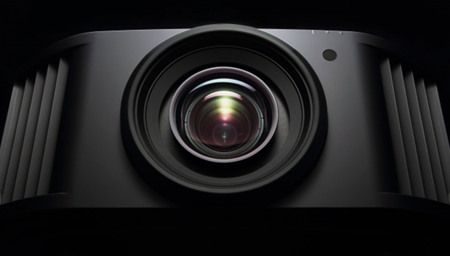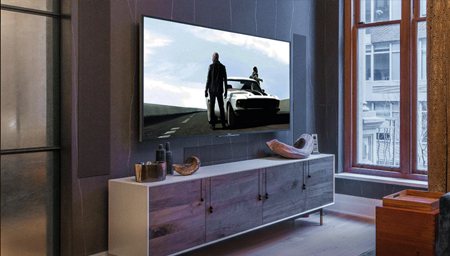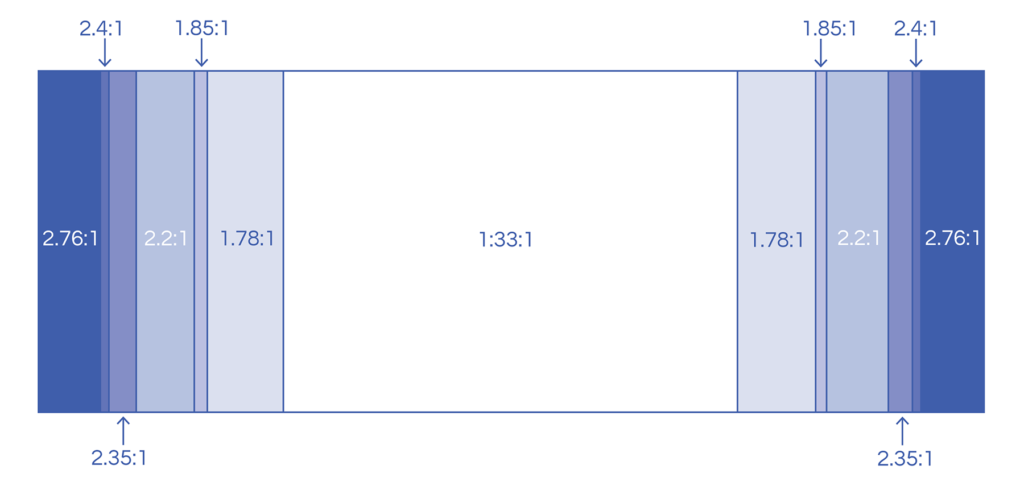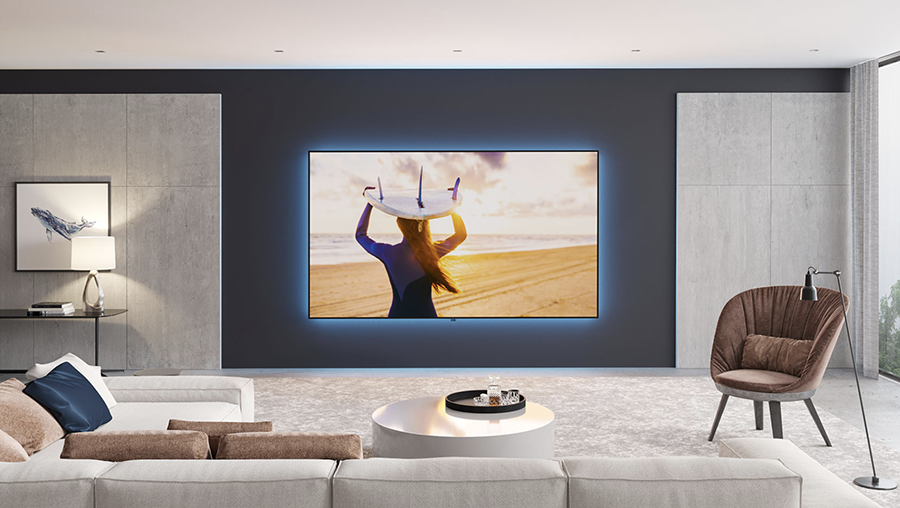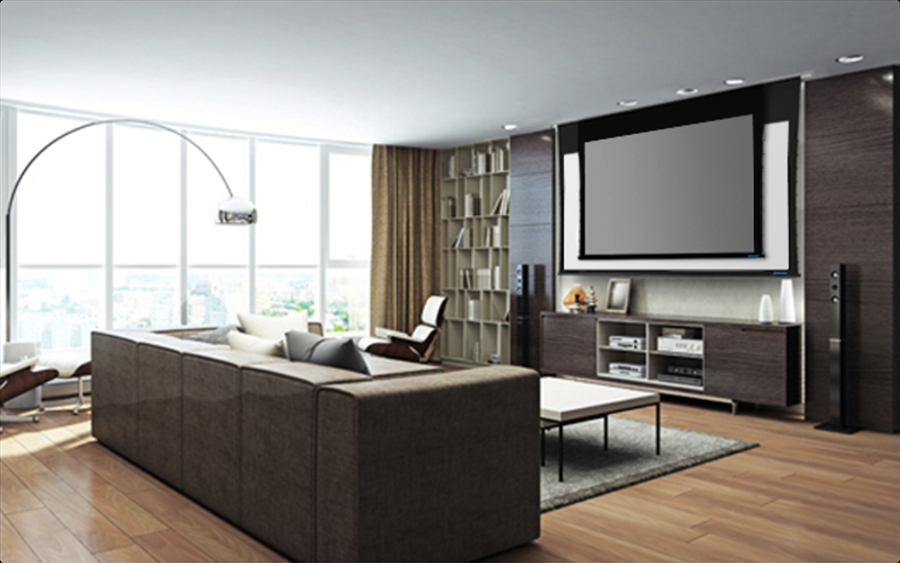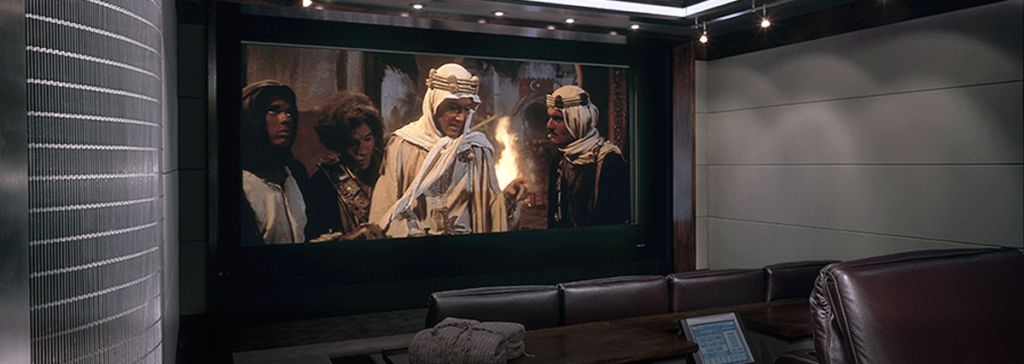
What Makes a Projection Screen Luxury?
related articles
click on the image to enlarge
some common aspect ratios
Offering many options for both performance and design, contemporary premium screens are no longer just a fixed white rectangle on the wall
by John Sciacca
updated December 11, 2021
The natural followup to “What Makes a Projector Luxury?” is to talk about projection screens. Projection systems—whether front or rear—are often referred to as “two-piece” because the projector and screen play near equal roles in delivering the best image quality possible.
No matter how fantastic your projector is the image you‘re watching is reflected off of a screen, and an inferior one will rob a projector of its maximum performance potential by introducing artifacts or color shifts to the image or by just not reproducing all the micro-detail and resolution the projector is capable of delivering.
So, even though they will be made by different manufacturers, you should think of the projection and screen as a system that works together to deliver the ultimate experience. In addition to things like size, style, and aspect, you should discuss the best screen material pairing with your integrator to ensure you’re selecting a combination that optimally works together.
There are a lot of screen manufacturers, with models selling from hundreds to thousands of dollars. Here, we’re going to discuss five elements that differentiate a luxury screen design.
BETTER BUILD QUALITY
Like any premium product, a luxury screen exhibits better build quality. This means frame corners that meet perfectly and screen material that’s tensioned to remain perfectly flat. A fixed screen (as opposed to a motorized model that rolls up and down) will likely have a velvet-like coating around the frame to absorb stray light, and draw the eye into the picture and enhance perceived contrast. Or you might elect to have a screen that has virtually no frame around it, like Screen Innovations’ Zero Edge, which more resembles a clean, elegant flat-panel TV. Premium motorized models employ quieter motors that sound more like a luxury window shade in operation. And, since the screen is the most visible part of most theater systems, it’s important to have one that looks good whether the lights are on or off.
While not part of build quality per se, luxury screen systems also offer more ways to interface with advanced control systems, either via contact closures, relays, infra-red, RS-232, or IP. This ensures the screen can accept the correct cues from, say, a Kaleidescape system when you’re switching from a movie of one aspect ratio to another.
MASKING SYSTEM
Speaking of aspect ratios, the best luxury screens incorporate masking, a black material that closes off, or “masks,” the unused screen area so just the image is visible. This eliminates any distracting white space around the image. Most screens sold are 16:9 aspect ratio, but most content—both movies and streaming—is in a wider format, typically 2.40:1, which results in black bars on the top and bottom of the image.
The vast majority of projectors are still widely based on a 16:9 chipset (although some Barco models use a true 2.37:1 light engine that make them an excellent candidate for a home cinema), so content with any ratio other than 16:9 will have black bars showing. And these bars aren’t truly black because the projector is emitting some stray light, which ends up lowering the image’s contrast ratio. So having masking to cover these unused parts of the image improves the picture quality.
But aspect ratios can be tricky since filmmakers choose different ones based on the look they’re hoping to achieve. For example, older films like The Maltese Falcon or Casablanca are 1.33:1; many documentaries like The Alpinist are 1.78:1; some directors prefer 1.85:1, such as Spielberg for Saving Private Ryan, E.T., and Jurassic Park; and you have “widescreen” films like Lawrence of Arabia at 2.2:1, Star Wars at 2.35:1, Bohemian Rhapsody at 2.40:1, and Ben Hur at 2.76:1
The ultimate solution is a system that can adjust all four sides of the screen image, like the Stewart Filmscreen Director’s Choice or Seymour Screen’s True Aspect Masking (TAM 4), which incorporate a four-way masking system. This is the epitome of a true Hollywood-esque screening-room experience, with the ability to frame the content so the black bars are invisible and only the content is shown, whatever the aspect ratio.
SCREEN MATERIAL
Choosing the correct screen material is about more than just its color. Screens use something called gain, which can increase or decrease the amount of light coming off the screen but can also limit the viewing angle. (It might seem counterintuitive to call something that can decrease the amount of light “gain,” but there are actually negative gain screens—anything less than a gain of 1.0—that are designed to help increase a projector’s black level.)
You might think that having a screen with a lot of gain would be the best solution but that type of screen introduces artifacts known as “hotspotting,” where images are noticeably brighter in the middle of the screen than at the sides, and “color shifting,” where colors can look different depending on where the viewer is seated. Discussing your media room needs based on its size, seating layout, and lighting conditions with a qualified installer will allow them to guide you in selecting the correct screen material for your projector and installation. Stewart Filmscreen, for example, offers more than 25 options, guaranteeing there is the correct material available regardless of the size, projector, or seating layout.
Stewart has a white paper on how its screens are capable of resolving six line pairs of arc minutes per millimeter, or, more to the point, can deliver detail that would exceed 16K resolution. This clearly illustrates how the screen you buy today can be truly future-proof for whatever projection technology is developed.
Another significant advance in screen technology is Ambient Light Rejecting (ALR) fabric. These models are designed to reflect ambient light away from the viewer while returning most of the light from the projector to the viewer, allowing you to enjoy a front-projection system in a room without total light control. One of the most popular ALR screens is Screen Innovations’ Black Diamond, which is now available in a variety of sizes and configurations and opens a host of new installation possibilities.
DIFFERENT SCREENS FOR DIFFERENT CONDITIONS
Say you have a room you use for a variety of activities—maybe for a lot of gaming or TV watching during the day but primarily for movie watching at night. Or maybe sometimes you like to watch with the lights up, and other times you want it pitch-black. A screen that works best for one of these situations might not be right for the other. One incredibly innovative and unique solution for this is Stewart’s Gemini.
While masking screens exist to accommodate a variety of aspect ratios, Gemini addresses the variety of usage. While watching movies often suggests a completely light-controlled environment, with the content frequently in Cinemascope, 2:35 to 2:40 ratio, watching TV is often done with lights on and the content in 16:9. The screen material choice for one activity is likely the wrong choice for the other, and vice versa. Gemini is a dual-roller motorized screen that can deploy two completely different screens—different fabrics, different ratios, and even different sizes. This ensures having the perfect experience regardless of the situation—say an ambient-light-rejecting material for day viewing and a reference white for night—giving viewers the best performance whatever the situation.
ACOUSTICALLY TRANSPARENT
Another significant benefit of a luxury screen is the ability to use a material that’s acoustically transparent. Initially, these screens used lots of tiny holes—micro-perforations—in the fabric to allow sound to pass through, exactly as it is done in a commercial theater. But all of these holes allowed the projector’s light to pass through as well, resulting in a loss of brightness. And the holes could actually interact with the pixel structure of the projector and introduce a video artifact known as moiré.
While perforation technology has advanced to address these issues, another option is becoming more preferred—using a woven fabric material that that allows sound to pass through without being degraded by the screen. This was originally pioneered by Screen Research with its award-winning ClearPix material, which has received both ISF (for video quality) and THX (for audio quality) certification for its lack of negative effects on the video or audio quality of the system. Kind of like a special-purpose speaker grille cloth, these screens let you position your main three front speaker channels directly behind the screen just like at a movie theater This means you don’t have to worry about the speakers’ design having an impact on the overall look of the room, which can allow the installer to use a larger/better speaker that otherwise wouldn’t fit with the décor. And having the speakers located behind the screen allows the audio cues to precisely track the onscreen action, perfectly marrying the picture and sound.
There is some science behind integrating a projector and screen along with the room layout, seating positions, and viewing habits, and your integrator will help with not only selecting ab appropriate screen size and material but also with the layout and integration of the entire system to make sure it delivers a truly premium experience.
While you will likely upgrade other components in your system—projector, processor, control system, sources—a quality projection screen is usually a buy-it-for-life decision, as it will probably never be outpaced by technology improvements. Because of this, buying the correct screen the first time becomes an important decision in the long-term investment in your entertainment.
Probably the most experienced writer on custom installation in the industry, John Sciacca is co-owner of Custom Theater & Audio in Murrells Inlet, South Carolina, & is known for his writing for such publications as Residential Systems and Sound & Vision. Follow him on Twitter at @SciaccaTweets and at johnsciacca.com.
© 2025 Cineluxe LLC


